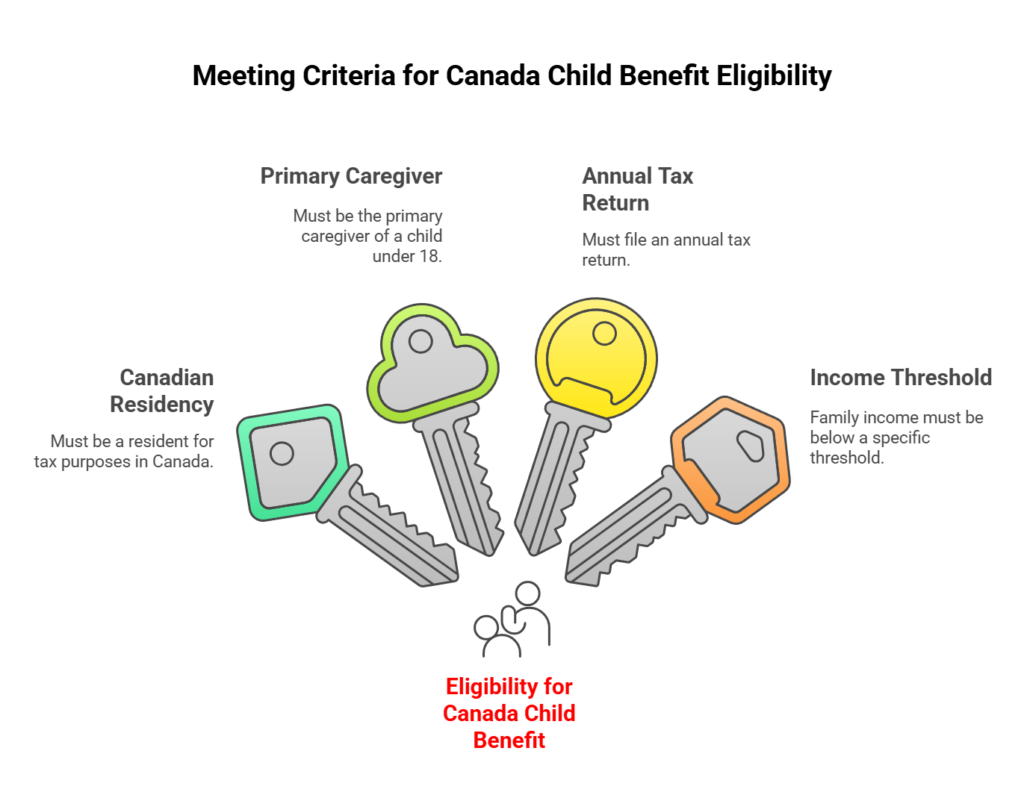Raising a family in Canada comes with significant financial responsibilities, from childcare costs to daily household expenses. For many families, the Canada Child Benefit (CCB) serves as a crucial financial lifeline, providing tax-free monthly payments to support child-rearing. But beyond covering day-to-day expenses, could this government benefit actually help secure a mortgage?
Lenders have traditionally favoured employment income for mortgage approvals, yet as Canada’s financial landscape evolves, non-traditional income sources like the CCB are gaining recognition. This guide explores how families can leverage CCB payments to strengthen mortgage applications, increase borrowing power, and move one step closer to homeownership.
What is the Canada Child Benefit (CCB)?
The Canada Child Benefit is a tax-free monthly payment provided by the Government of Canada to assist eligible families with the cost of raising children under 18 years old. Introduced in 2016, it replaced the previous Universal Child Care Benefit (UCCB) and Child Tax Benefit (CTB), offering a more income-dependent and progressive approach to financial assistance.
NOTE: While provinces offer their own Child Benefit programs, lenders generally do not allow these as a source of income. Usually, only the Canada Child Benefit (CCB) is acceptable and often with limitations depending on lender.
Eligibility Criteria
To qualify for the CCB, an applicant must:
- Be a Canadian resident for tax purposes
- Be the primary caregiver of a child under 18
- File an annual tax return
- Have a family income below the designated threshold (amount varies based on household size)

How Much Can Families Receive?
The amount of CCB payments varies based on income. As of 2024, the maximum annual benefit per child is:
- $7,437 per year ($619.75/month) for children under 6 years old
- $6,275 per year ($522.91/month) for children aged 6 to 17
Lower-income families receive the highest benefit amounts, while high-income households may receive reduced or zero benefits.
The Role of CCB in Household Finances
The CCB serves as a critical supplement to household income. While many families use it for childcare, groceries, or savings, some borrowers leverage it to increase mortgage affordability. Because CCB is tax-free and government-backed, it represents a stable and predictable source of cash flow—an important consideration for lenders.
However, while some financial institutions recognize CCB as valid income, others remain hesitant, citing concerns about long-term income sustainability as children grow older.
Can You Use the CCB for a Mortgage?
The answer depends largely on the lender.
- A Lenders (Big Banks): Most major banks count CCB as qualifying income, but it must not exceed a given percentage of employment or total income (usually 15% to 25%, although TD will go to 50%). There are also age restrictions (Scotia will go to 12 years while B2B will take it to 21 years).
- B Lenders (Alternative Lenders): More flexible in terms of age, verification, and percentage and may accept partial or full CCB income. For example, Haventree Bank will do 100% and put no limitation on how much CCB can be used.
- Private Lenders: Typically very accommodating because they are doing collateralized lending.
A major factor in approval is the age of the children—if they are close to turning 18, lenders may be reluctant to include CCB income or if the children are turn 18 before the end of the mortgage term.
The Documentation Required for Using CCB in a Mortgage Application
When applying for a mortgage with CCB as part of the income, borrowers must demonstrate consistency and reliability. Lenders will require:
- Official CCB Statements from the CRA – These documents show monthly benefit amounts and eligibility details.
- Bank Statements (Last 3–6 Months) – Lenders need to see regular direct deposits from the government.
- Birth Certificates or Custody Agreements – Proof that the applicant is the legal guardian of the child receiving the benefit. However, many lenders are willing to accept verbal confirmation.
- Tax Returns (NOAs or T1 Generals) – These help confirm annual income and government benefit amounts.
Failing to provide proper documentation could result in the lender disregarding CCB income, even if they normally accept it.
Age Limitations on Children for Mortgage Qualification
One of the biggest challenges with using CCB for a mortgage is age restrictions.
Many lenders only accept CCB if the child is under 12 or 15—this ensures the benefit will continue for a significant portion of the mortgage term.
If the child is close to 18, most lenders will disqualify CCB income, as it will soon cease.
Borrowers with multiple young children have a better chance of having CCB considered, as payments will continue for many years.
This limitation often makes alternative lenders or private lenders the best options for applicants who are relying heavily on CCB for mortgage qualification.
Debt Service Ratios and the Inclusion of CCB
Lenders use Gross Debt Service (GDS) and Total Debt Service (TDS) ratios to determine how much mortgage debt a borrower can afford.
Gross Debt Service (GDS) Ratio
The percentage of gross income allocated to mortgage payments, property taxes, heating, and condo fees.
Most lenders require GDS to be under 39%.
Total Debt Service (TDS) Ratio
Includes all monthly debt obligations (e.g., credit cards, car loans, student loans).
TDS should be under 44% for most mortgage approvals.
CCB can help borrowers lower their GDS and TDS ratios, improving affordability. However, lenders that accept CCB may only count a percentage of it.
The Advantage of Alternative Lenders for CCB-Dependent Borrowers
For borrowers struggling to qualify with traditional banks, alternative lenders provide a lifeline.
More Flexible Income Calculations – B lenders are more flexible and willing to consider CCB, making homeownership more accessible for families.
Higher Debt Tolerance – B lenders allow higher GDS/TDS ratios (above 39%/44%), increasing the mortgage amount a borrower can qualify for.
Easier Approval for Self-Employed or Low-Income Borrowers – Many alternative lenders cater to non-traditional applicants.
However, borrowers must be prepared for higher interest rates and possibly additional lender fees.
Common Pitfalls When Using CCB as Income
Some borrowers overestimate how much CCB will help with their mortgage qualification. Common mistakes include:
Inconsistent Deposits – Lenders want to see regular, uninterrupted payments. If deposits fluctuate or stop, they may be disregarded.
Children Too Close to 18 – If a child is nearing adulthood, lenders may refuse to count CCB at all.
Over-Reliance on CCB – Borrowers should combine CCB with stable employment income to strengthen their application.
Not Shopping Around for the Right Lender – Some applicants assume all lenders reject CCB, missing opportunities with B lenders or private lenders.
Can You Use CCB for a Down Payment?
Many borrowers wonder whether CCB can be used not just for mortgage qualification but also as a down payment.
CCB can help accumulate savings for a down payment over time.
Some lenders require a 90-day history of saved funds for a down payment.
CCB itself is not an eligible down payment source—but if saved properly, it can contribute.
Lenders will not allow CCB to be directly used as a down payment unless it has been saved in a bank account for a sufficient period.
Case Study: A Family Successfully Using CCB for Mortgage Approval
Scenario:
- Single mother of two, ages 3 and 7
- Annual salary: $40,000
- Canada Child Benefit: $12,000 per year ($1,000/month)
- Seeking a mortgage for $350,000
Challenges:
- Major banks rejected her application due to overreliance on CCB.
- She had no co-signer and limited savings.
Solution:
- Worked with a mortgage agent to find an alternative lender.
- B lender accepted 75% of her CCB income as part of debt servicing ratios.
- Approved for a mortgage with slightly higher interest but lower stress-test requirements.
This case highlights the importance of seeking out flexible lenders and strategically combining income sources.
Key takeaways
- CCB can improve mortgage qualification, but lender policies vary.
- Proper documentation is crucial. B lenders and private lenders are more likely to accept CCB income.
- Age restrictions apply—lenders may not count CCB if the child is over 12–15.
For families hoping to leverage CCB for homeownership, working with a mortgage agent can make all the difference in finding a lender willing to recognize this valuable income source.
Summary
The Canada Child Benefit can play a crucial role in securing mortgage financing, but its acceptance depends entirely on the lender. While big banks often exclude CCB from income calculations, alternative lenders and private mortgage providers may consider it—especially for borrowers with multiple young children.












